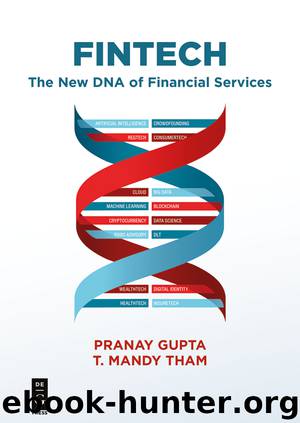Fintech by Pranay Gupta

Author:Pranay Gupta
Language: eng
Format: epub
Publisher: De|G Press
Published: 2019-10-25T16:00:00+00:00
The Future
Already, it is possible to conceive of a virtual corporate and investment bank that could challenge and replace the conglomerates that were built from waves of consolidation in the 1980s and 1990s (and which may still run systems using code from even earlier decades). Building a digital bank from scratch will not be done primarily through M&A, but through the delivery of a unique value proposition via the aggregation of an easily interchangeable range of resources and capabilities, only the most quintessential of which will be developed in-house. Whether such a proposition will be brought to market by a tech-savvy bank or the banking arm of a tech giant is hard to say.
A quick look at any sub-sector of the trading and investment universe indicates the pace of fintech-driven change and the risks of making predictions. Fintech first made itself known in the wealth management space via robo-advisors, offering lowcost investments to the mass affluent, via menu-driven, AI-assisted platforms in competition with US financial advisors. But they soon became much more sophisticated and diverse, deployed to meet the precise demands of high-net worth individuals either directly as sophisticated apps or as relationship management tools for private banks. In either case, the key to value lies in the aggregation and integration of multiple front- and back-end capabilities, with enhancements, recommendations, and customizations informed by a data-driven feedback loop.
Across the spectrum, the opportunity is enormous. How far can fintech take automation of bond trading, for example? Over-the-counter markets may have been resistant to technology for a long time, but growing use of robotics suggests humans can be taken further out of the loop. And soon. By using robotics technology, bond investors and traders will soon be able to place an order and then leave the robot to navigate the all-to-all trading environment. If an offer or an RFQ pops up in the specific issue sought, the robot will respond, not only activating the order, but also countering RFQs with specific bids and sizes based on several parameters.
Further, cognitive functions (driven by machine learning and natural language processing) will enable trading robotics to move up the evolutionary ladder, learning from experience. If, for example, a bond market enters a panic sell-off mode, the robot will “remember” past similar occurrences and recall which venue has the highest probability of liquidity and also have a precise idea of the firm price levels to expect compared to indicative prices, the total slippage for a position unwinding, as well as expected maximum trading sizes available. The combined impact of new technology, new fintech participants, regulations, and a wish for efficiency and scalability have the potential power to transform the bond markets within the next three years.
One safe prediction is that APIs will continue to mature and diversify. Indeed, increasing efforts are being made on standardization to ensure continued interoperability of APIs even as they develop and specialize. One sign of API maturity in recent years is the evolution away from REST APIs, for which data is sent only in response to an incoming query.
Download
This site does not store any files on its server. We only index and link to content provided by other sites. Please contact the content providers to delete copyright contents if any and email us, we'll remove relevant links or contents immediately.
International Integration of the Brazilian Economy by Elias C. Grivoyannis(98393)
The Radium Girls by Kate Moore(11967)
Turbulence by E. J. Noyes(7977)
Nudge - Improving Decisions about Health, Wealth, and Happiness by Thaler Sunstein(7654)
The Black Swan by Nassim Nicholas Taleb(7054)
Rich Dad Poor Dad by Robert T. Kiyosaki(6506)
Pioneering Portfolio Management by David F. Swensen(6253)
Man-made Catastrophes and Risk Information Concealment by Dmitry Chernov & Didier Sornette(5951)
Zero to One by Peter Thiel(5729)
Secrecy World by Jake Bernstein(4698)
Millionaire: The Philanderer, Gambler, and Duelist Who Invented Modern Finance by Janet Gleeson(4417)
The Age of Surveillance Capitalism by Shoshana Zuboff(4243)
Skin in the Game by Nassim Nicholas Taleb(4200)
Bullshit Jobs by David Graeber(4136)
The Money Culture by Michael Lewis(4127)
Skin in the Game: Hidden Asymmetries in Daily Life by Nassim Nicholas Taleb(3960)
The Dhandho Investor by Mohnish Pabrai(3721)
The Wisdom of Finance by Mihir Desai(3691)
Blockchain Basics by Daniel Drescher(3535)
